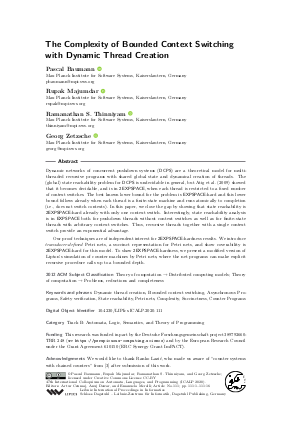@InProceedings{baumann_et_al:LIPIcs.ICALP.2020.111,
author = {Baumann, Pascal and Majumdar, Rupak and Thinniyam, Ramanathan S. and Zetzsche, Georg},
title = {{The Complexity of Bounded Context Switching with Dynamic Thread Creation}},
booktitle = {47th International Colloquium on Automata, Languages, and Programming (ICALP 2020)},
pages = {111:1--111:16},
series = {Leibniz International Proceedings in Informatics (LIPIcs)},
ISBN = {978-3-95977-138-2},
ISSN = {1868-8969},
year = {2020},
volume = {168},
editor = {Czumaj, Artur and Dawar, Anuj and Merelli, Emanuela},
publisher = {Schloss Dagstuhl -- Leibniz-Zentrum f{\"u}r Informatik},
address = {Dagstuhl, Germany},
URL = {https://drops.dagstuhl.de/entities/document/10.4230/LIPIcs.ICALP.2020.111},
URN = {urn:nbn:de:0030-drops-125187},
doi = {10.4230/LIPIcs.ICALP.2020.111},
annote = {Keywords: Dynamic thread creation, Bounded context switching, Asynchronous Programs, Safety verification, State reachability, Petri nets, Complexity, Succinctness, Counter Programs}
}

 Creative Commons Attribution 3.0 Unported license
Creative Commons Attribution 3.0 Unported license













